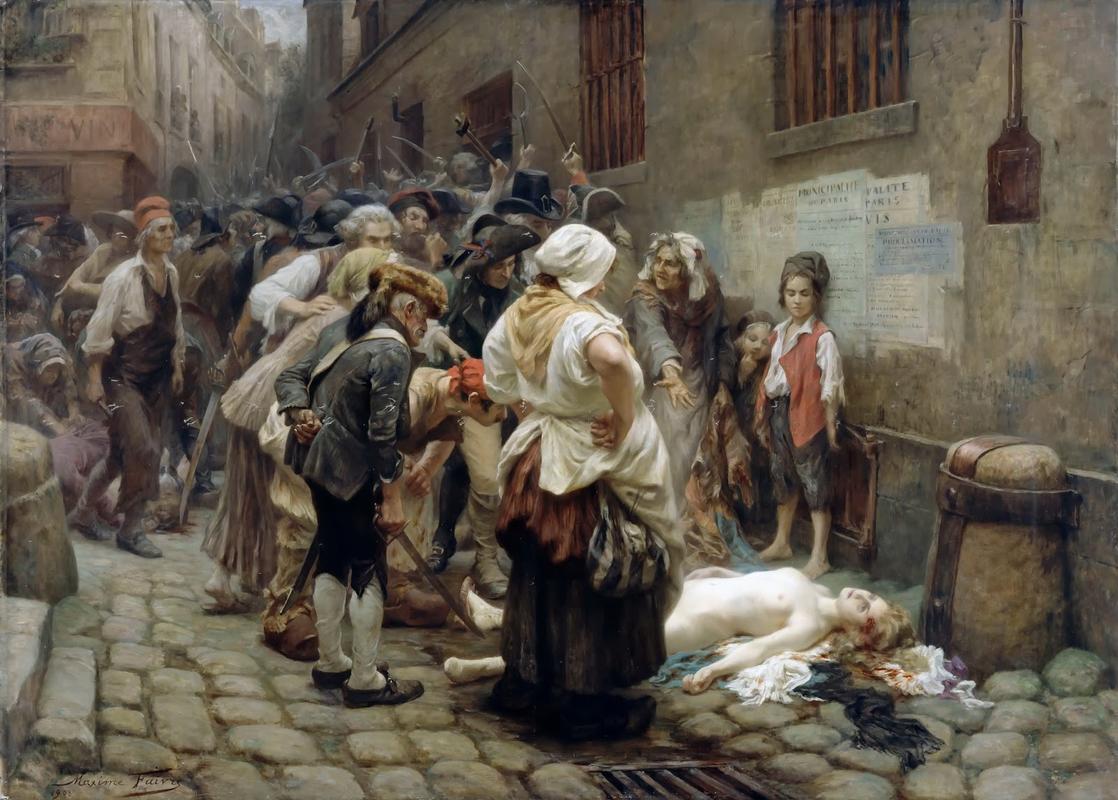More about Death of the Princess de Lamballe

Contributor
Was Marie Thérèse, Princesse de Lamballe the best person? No, but did she deserve to be stripped naked, stabbed countless times by an angry mob, and then have her decapitated head paraded around? Well, I don’t think anyone really deserves that...
Léon-Maxime Faivre’s Death of Princess Lamballe depicts a gruesome event in France’s history: the September Massacres during the Reign of Terror in France. The subject of Faivre’s painting, the unfortunate woman lying dead and stark naked in the middle of the street, is Marie-Thérèse-Louise de Savoie-Carignan, Princesse de Lamballe (damn Game of Thrones wasn’t exaggerating, royal people really do have long names). Until the devastation caused by the Reign of Terror, Marie Thérèse lived a privileged life. She was born in northern Italy to the Prince and Princess of Carignano. At the age of eighteen, she was married to the wealthiest man in France, Louis Alexandre Bourbon-Penthiévre, Prince of Lamballe. Unfortunately, they only ended up being married for one year as Louis Alexandre spent too many nights hanging out with “friends” and contracted a fatal venereal disease.
Before we get to the circumstances of the princess’s death, I have to point out that the consequences of political unpopularity during the French Revolution are very different than the criticism that politicians receive today. During this time period, if an angry mob caught you and they didn’t like your public policies or even just the fact that you were rich, you could face anything from decapitation by guillotine to being tied to your loved ones and thrown in the river to drown. Seems like overkill to me, but hey, murdering every politician that you don’t agree with is an effective way to change government policies.
That being said, Marie Thérèse had two strikes against her in the eyes of the people: she was richer than Croesus and openly supported the aristocracy. Then after her husband died, when she joined Queen Marie Antoinette’s court and won her affection, she became extremely powerful too. Even though Marie Thérèse was quite reserved and openly charitable, she was still quite disliked by the public long before the Reign of Terror purely for being rich and influential. The tabloids of the time often printed obscene, pornographic cartoons suggesting that the Queen and she were lesbian lovers. These papers did not leave anything to the imagination, let’s just say that they would definitely be NSFW.
So you can see how that by the time the Reign of Terror rolled around that it was not surprising that Marie Thérèse’s head was on the chopping block (guillotine pun intended). Towards the end of August in 1792, she was imprisoned with many other aristocrats. It was hoped that placing the aristocracy in jail would also serve the purpose of keeping them safe during the riots; however, the events of the September Massacres show you should never underestimate the power of an angry mob. The prison was overrun and prisoners were dragged out, given hasty trials by the mob, and swiftly executed as a bloodlust overtook the crowd. Marie Thérèse was one of these unfortunate souls. When stood in front of the ragtag tribunal, she was asked to “take an oath to love liberty and equality and to swear hatred to the King and the Queen and to the monarchy.” She took the oath but would not denounce the royal family saying she would agree “readily to the former; but I cannot to the latter: it is not in my heart.”
What occurred next has taken on the aspects of myth and legend. Many versions of exactly how Marie Thérèse died exist, some are downright horrific like that she was raped and her breasts removed; however, there is no conclusive evidence to support those theories. Most eyewitness reports conclude that she was taken into a nearby courtyard, already strewn with corpses of fellow aristocrats, where she was first struck on the head with a pike and then stabbed to death by the mob. Most would think that a good public stabbing would have been enough to satiate the bloodlust of the mob. But no, her head was then removed and paraded through the streets of Paris. So I guess the moral behind the story of Death of Princess Lambelle is that even the richest and kindest people can still be beheaded *cough* Ned Stark *cough*.
Sources
- http://www.mheu.org/en/timeline/death-princess-lamballe.htm
- https://archive.org/stream/cu31924024292504/cu31924024292504_djvu.txt
- The Princesse de Lamballe: A Biography By Blanche C. Hardy
- Glory and Terror: Seven Deaths Under the French Revolution By Antoine De Baecque
- https://www.ranker.com/list/french-revolution-bloodiest-moments/setareh…











